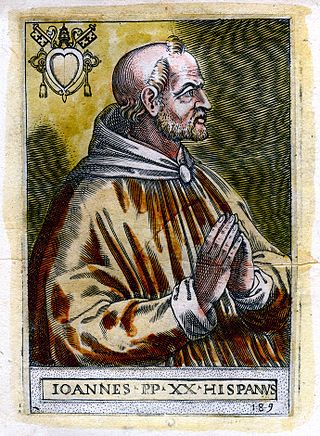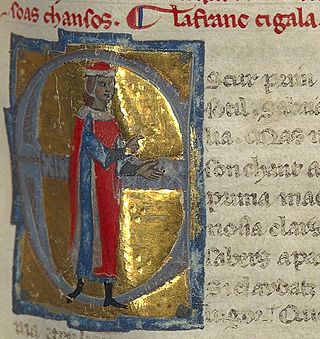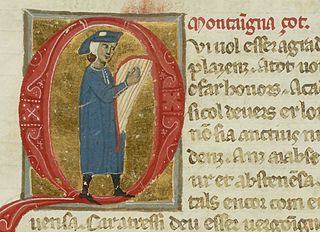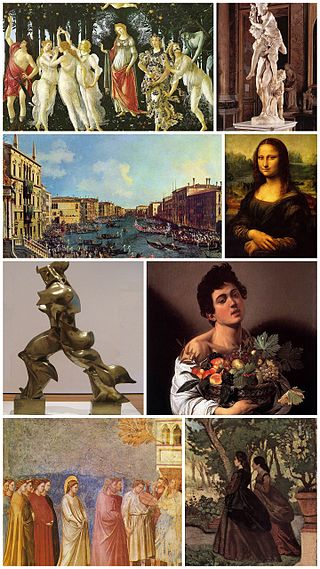Births
| | This section is empty. You can help by adding to it. (July 2010) |
| |||
|---|---|---|---|
| +... |
| | This section is empty. You can help by adding to it. (July 2010) |

Year 1276 (MCCLXXVI) was a leap year starting on Wednesday of the Julian calendar.

In classical Greek rhetoric, topos, pl.topoi,, in Latin locus, refers to a method for developing arguments.
Dolce Stil Novo, Italian for "sweet new style", is the name given to a literary movement in 13th and 14th century Italy. Influenced by the Sicilian School and Tuscan poetry, its main theme is Divine Love. The name Dolce Stil Novo was used for the first time by Dante Alighieri in Purgatorio, the second canticle of the Divina Commedia. In the Divina Commedia Purgatory he meets Bonagiunta Orbicciani, a 13th-century Italian poet, who tells Dante that Dante himself, Guido Guinizelli, and Guido Cavalcanti had been able to create a new genre: a stil novo.
Guido Guinizelli was an esteemed Italian love poet and is considered the "father" of the Dolce Stil Novo. He was the first to write in this new style of poetry writing, and thus is held to be the ipso facto founder. He was born in, and later exiled from, Bologna, Italy. It is speculated that he died in Verona, Italy.

Guido Cavalcanti was an Italian poet. He was also a friend and intellectual influence on Dante Alighieri.

Luigi Ballerini is an Italian writer, poet, and translator.

The Sicilian School was a small community of Sicilian and mainland Italian poets gathered around Frederick II, most of them belonging to his imperial court in Palermo. Headed by Giacomo da Lentini, they produced more than 300 poems of courtly love between 1230 and 1266, the experiment being continued after Frederick's death by his son, Manfred.
Italian poetry is a category of Italian literature. Italian poetry has its origins in the thirteenth century and has heavily influenced the poetic traditions of many European languages, including that of English.

Cino da Pistoia was an Italian jurist and poet. He was the university teacher of Bartolus de Saxoferrato and a friend and intellectual influence on Dante Alighieri.
Lapo Gianni was an Italian poet who lived in Florence in the 13th-14th centuries. He was a member of the Florentine circle of the Italian movement called Dolce Stil Novo, and was probably a notary. His composition are distinguished for lightness and originality. Of him eleven ballads and six songs remain. Lapo Gianni is also cited by Dante Alighieri in the famous 9th sonnet of the Rhymes.

Lanfranc Cigala was a Genoese nobleman, knight, judge, and man of letters of the mid thirteenth century. He remains one of the most famous Occitan troubadours of Lombardy. Thirty-two of his poems survive, dealing with Crusading, heresy, papal power, peace in Christendom, and loyalty in love. Lanfranc represented a tradition of Italian, Occitan-language trovatori who berated the Papacy for its handling of the Crusades.

In Old Occitan literature, a tornada refers to a final, shorter stanza that appears in lyric poetry and serves a variety of purposes within several poetic forms. The word tornada derives from the Old Occitan in which it is the feminine form of tornat, a past participle of the verb tornar. It is derived from the Latin verb tornare.

Guilhem de Montanhagol was a Provençal troubadour, most likely active in Toulouse, but known in the courts of Provence, Toulouse, Castile, and Aragon. Guilhem left behind seven cansos and six sirventes. He also left behind one tenso with Sordello and his total surviving output comes to fourteen pieces.
Dante da Maiano was a late thirteenth-century poet who composed mainly sonnets in Italian and Occitan. He was an older contemporary of Dante Alighieri and active in Florence.

(La) Nina Siciliana was the composer of one Italian sonnet, and a candidate to be the first Italian woman poet. She only came to light in 1780, along with 74 other poets, in the Étrennes du Parnasse. She is now considered legendary by most scholars.
Chiaro Davanzati was an Italian poet from Florence, one of the Siculo-Tuscan poets, who introduced the style of Sicilian School to the Tuscan School. He was one of the most prolific Italian authors before Dante: at least 122 sonnets and sixty-one canzoni by Chiaro are known, many of them in tenzone with other poets. Only Guittone d'Arezzo produced more lyrics in the thirteenth century.
Bonagiunta Orbicciani, also called Bonaggiunta and Urbicciani, was an Italian poet of the Tuscan School, which drew on the work of the Sicilian School. His main occupation was as a judge and notary. Fewer than forty of his poems survive.

Duecento or Dugento is the Italian word for the Italian culture of the 13th century - that is to say 1200 to 1299. During this period the first shoots of the Italian Renaissance appeared, in literature and art, to be developed in the following trecento period.